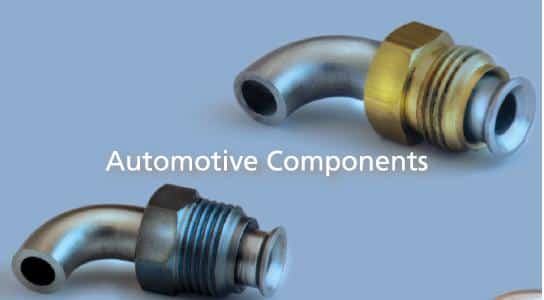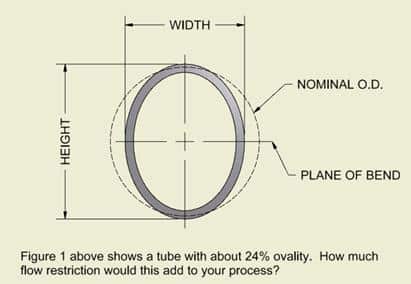Are Your Ovality Requirements Impeding Your Tube Bending Process?
The Background
If you have ever been involved with bending tubing, chances are you have had a need to control the roundness of the tube/pipe in the bend zone. When it comes to bending a tube, the roundness of a tube in the bend zone is often referred to as the % ovality of the tube. Thus, if a tube flattens by any significant amount, then the fluid that is intended to pass thru the tube will experience more of a restriction; see Figure 1. It is just like a garden hose; pinch the hose enough and the flow will stop.
In Figure 1 the diameter of the tube in the plane of bend is reduced by a certain amount. For the plane perpendicular to the plane of bend the vertical diameter (height) has a tendency to grow during bending. Quite often both the width and height of the tube are used to calculate the % ovality. One example of how to calculate the % ovality makes use of the following equation: % Ovality = 100 x (Tube Height – Tube Width) / Tube Nominal OD
What Are Your Needs?
Now this is all well and good however not all applications need the very best ovality. For the most part, tight bend radii that require great ovality cost more to manufacturer. And maybe you need this. My experience suggests that ovality is industry dependent.
On an aircraft, maybe you need 3% to 5% ovality. But do you in all aircraft applications? This is what the industry has demanded from generation to generation from one engineer to the next. This quality requirement has been handed down in stone. How about the refrigeration market? I have seen where 35% ovality is acceptable. Why? Because someone, years ago, who was motivated to reduce the cost of goods sold while at the same time maintaining quality investigated what effect 35% ovality would have on the end product. Well, as it turns out a significant amount of refrigerant will still pass thru an oval cross section; see Figure 1.
The OEMs who are willing to accept this level of ovality are then able to pursue more efficient means of tubular manufacturing. Yes, this has been known to happen. Sometimes there just isn’t the right motivation to investigate the effects of ovalities exceeding 20%. Far too often I have come across an engineer who wouldn’t budge form the way it has always been done.
Maybe your customers will not accept excessive flattening; case in point would be light fixtures. In this case the cosmetics aspect of a quality bend are important. In the case of heat exchangers that pass gas or water, the questions becomes: do you stay with the same old same old or are you driven to reduce the cost of goods sold without impacting quality to the end user? Sometimes change is good.

George Winton, P.E. designs and builds CNC tube fabrication equipment for Winton Machine in Suwanee, GA. He can be reached at gwinton@wintonmachine.com or 888.321.1499.
About the Machines We Build
All of our semi-rigid coax and tube fabrication machines at Winton are designed, manufactured, and tested in-house. We have a large line of standard products as well as the ability to engineer the best solution for our customer’s needs. Our experienced sales staff makes sure that our customers can justify their capital equipment investment by offering a solution that is exactly what they need in order to manufacture their parts. Please contact us today to discuss your project.



